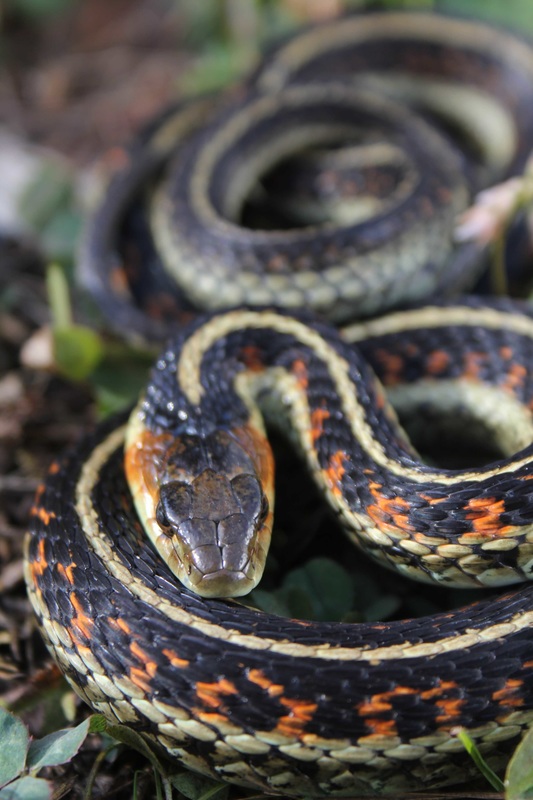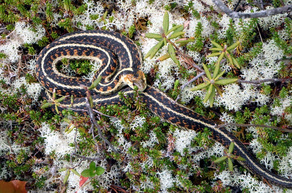Common garter snake • Thamnophis sirtalis
Identification
The common garter snake has a dark greyish-green to black body marked by three yellow to greenish-yellow stripes (two lateral and one dorsal). The stripes are usually fairly distinct but may occasionally appear faint or even absent. There are often red blotches or bars between the dorsal and lateral stripes. The head is large and distinct from the neck. Adult common garter snakes range from 46 cm to 1.3 m. There are three subspecies; snakes of the species found on the Central Coast belong to the subspecies pickeringi, the Puget Sound garter snake.
Habitat & Range
The common garter snake lives in a variety of habitats, including grasslands, forests, riparian areas and aquatic habitats, marshes, and city parks. It requires areas with cover for protection from sunlight and predators, good hunting locations (often near water), and an underground den (hibernaculum) to hibernate during the winter. It is found throughout the middle and southern portion of BC. It is widespread across much of southern Canada and the United States.
Similar Species
The northwestern garter snake (Thamnophis ordinoides) varies greatly in colour; while it is usually dull brownish-grey with a faint checkered pattern, some individuals may have dorsal and lateral stripes interspersed with markings similar to the common garter snake. In such cases size and relative head size should be examined: the northwestern garter snake is usually less than 60 cm long, and has a small head not distinct from the neck. It also has a pale top lip.
The western terrestrial garter snake (T. elegans vagrans) may also bear similar stripes and spots, however it is usually lighter in colour with dark spots.
Intriguing Info
The common garter snake hunts amphibians, slugs, and insects, as well as other reptiles, birds, small mammals, and fish. It is able to eat toxic animals like the rough-skinned newt and the western toad without suffering any major ill effects.
The common garter snake has a dark greyish-green to black body marked by three yellow to greenish-yellow stripes (two lateral and one dorsal). The stripes are usually fairly distinct but may occasionally appear faint or even absent. There are often red blotches or bars between the dorsal and lateral stripes. The head is large and distinct from the neck. Adult common garter snakes range from 46 cm to 1.3 m. There are three subspecies; snakes of the species found on the Central Coast belong to the subspecies pickeringi, the Puget Sound garter snake.
Habitat & Range
The common garter snake lives in a variety of habitats, including grasslands, forests, riparian areas and aquatic habitats, marshes, and city parks. It requires areas with cover for protection from sunlight and predators, good hunting locations (often near water), and an underground den (hibernaculum) to hibernate during the winter. It is found throughout the middle and southern portion of BC. It is widespread across much of southern Canada and the United States.
Similar Species
The northwestern garter snake (Thamnophis ordinoides) varies greatly in colour; while it is usually dull brownish-grey with a faint checkered pattern, some individuals may have dorsal and lateral stripes interspersed with markings similar to the common garter snake. In such cases size and relative head size should be examined: the northwestern garter snake is usually less than 60 cm long, and has a small head not distinct from the neck. It also has a pale top lip.
The western terrestrial garter snake (T. elegans vagrans) may also bear similar stripes and spots, however it is usually lighter in colour with dark spots.
Intriguing Info
The common garter snake hunts amphibians, slugs, and insects, as well as other reptiles, birds, small mammals, and fish. It is able to eat toxic animals like the rough-skinned newt and the western toad without suffering any major ill effects.
References
Common Garter Snake. The Reptiles of British Columbia.British Columbia Ministry of Environment and Thompson Rivers University. Accessed 20/01/2015.
Common garter snake (Thamnophis sirtalis). ARKive. Accessed 20/01/2015.
Tuttle, K. Thamnophis sirtalis (Linnaeus, 1766).
Authors and editors of page
Kelly Fretwell and Brian Starzomski (2015).
Common Garter Snake. The Reptiles of British Columbia.British Columbia Ministry of Environment and Thompson Rivers University. Accessed 20/01/2015.
Common garter snake (Thamnophis sirtalis). ARKive. Accessed 20/01/2015.
Tuttle, K. Thamnophis sirtalis (Linnaeus, 1766).
Authors and editors of page
Kelly Fretwell and Brian Starzomski (2015).






